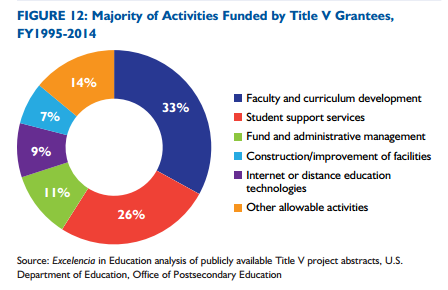

Hispanic-serving institutions should do more than just enroll large numbers of Latino students. As their title implies, they’re also supposed to serve them, according to experts on a panel Excelencia in Education hosted Wednesday in Washington, D.C.
The panel discussion coincided with the release of Excelencia’s latest report, “From Capacity to Success: HSIs, Title V, and Latino Students,” which analyzes the past 20 years of federal funding for colleges and universities where the full-time equivalent student population is at least 25 percent Latino.
“How do you get from enrolling to serving?” asked Excelencia’s Chief Operating Officer and Vice President for Policy Deborah Santiago. “This is where the rubber meets the road at the end of the day.”
As president and CEO of the Texas Association of Community Colleges, that’s what Jacob Fraire is trying to do. He’s found that “knowledge sharing” can make a difference — between colleges and universities educating large numbers of Latino students, and also between educators at the college level and their K-12 counterparts.
“Let us learn from these analyses and the ones that are forthcoming to begin an earnest conversation among ourselves…about what does it truly means to serve,” because that word is what it’s really all about, he said. “It’s about trying to get that right.”
Key things to look for when evaluating whether institutions are doing this well are whether they’re retaining and graduating Latino students, as well as reflecting student demographics in the faculty, Santiago said.
HSIs represent 13 percent of all institutions of higher education and educate 60 percent of the Latino college-going population. Using data from 2014, the report found that while there were 409 HSIs — 435 now — only 160 of those received federal Title V funds meant “to assist HSIs to expand educational opportunities for, and improve the attainment of, Hispanic students.”
It’s a competitive process, U.S. Department of Education HSI Division Director Beatriz Ceja, explained. Based on the demand for funds, even schools that score highly on their applications have been denied money.
“If we were to divide our appropriations right now by the number of institutions that are able to receive the funding, each one would get approximately $250,000 per year,” Ceja said. On average, current grants are awarded for $525,000 a year for up to five years for qualifying schools.

Does that money translate into higher retention and graduation rates? Santiago says there’s not a direct causal relationship between Title V funding and student success, but there are correlations and links.
Since the federal government started allotting money for HSIs 20 years ago, Latino college enrollment, degree attainment and persistence have gone up. From 1995 to 2014, the percentage of Latino adults who completed an associate degree or higher grew to 23 percent from 12 percent, and Latino recipients of a bachelor’s degree or higher increased from 9 to 15 percent, according to the report.
Students still aren’t necessarily graduating within two or four years in their chosen degree programs, but students at HSIs are twice as likely to persist if they’re at an HSI than elsewhere. Though it might take them four years at a community college or seven years to get a bachelor’s degree, they’re still enrolled, Santiago pointed out.
Because the growing number of HSIs is outpacing the amount of funding available, Ceja said her office is taking steps to make grantees more accountable by identifying the if/then relationship between the way the funds are used and student outcomes
Ceja said her desire is to emphasize “serving.” Currently, the process is input driven in terms of enrollment and core expenditures. “We’re going to look at the definition in terms of outputs,” she said.
Still, she’s confident that the investment is making a difference.
“Do we have room for improvement? We definitely do,” said Ceja, adding that it’s not time to “drop the mic” yet. “If anything it is time to actually pick up the mic…and to speak to the importance of Latino success, because Latino success is truly everyone’s success.”